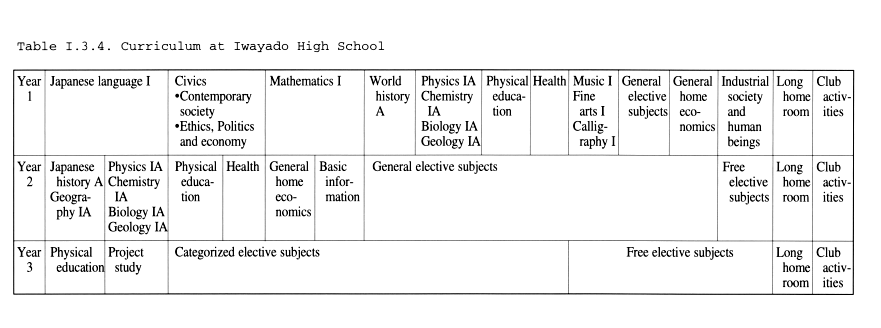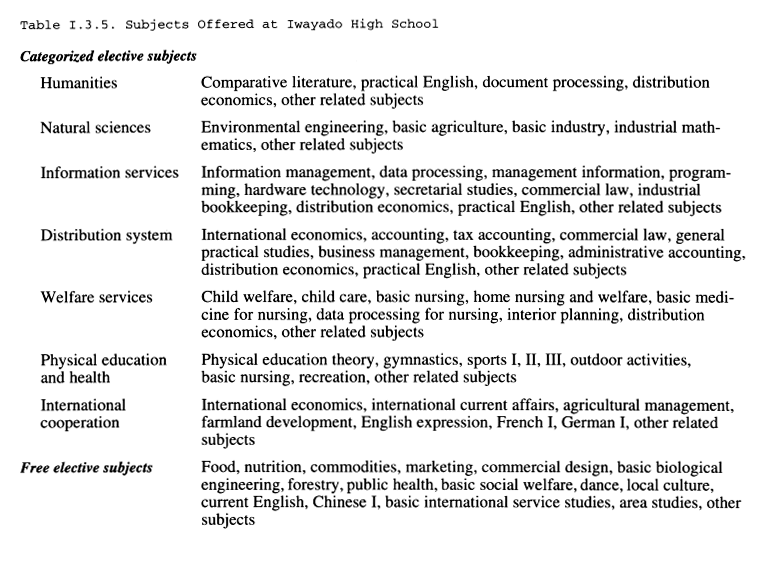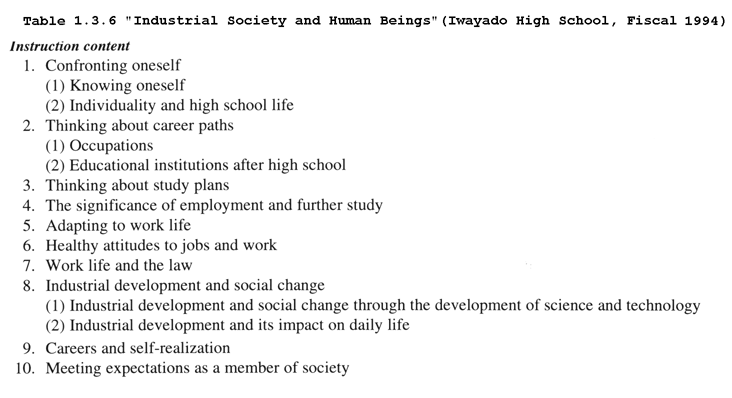| Home > Policy > White Paper, Notice, Announcement > White Paper > JAPANESE GOVERMENT POLICICIES IN EDUCATION, SCIENCE AND CULTURE 1994 > PART I Chapter 3 2 2 | ||
The most important characteristic of the integrated course is that it offers a wide variety of subject areas and subjects from both the general and the specialized courses while maintaining a structured approach. Students are able to select subjects independently, according to their individual abilities, aptitudes, interests, concerns, and career paths.
This is apparent from the actual subject areas and subjects that have been established under the integrated course since its introduction in fiscal 1994. As stated in section 1, for example, over 120 subjects were provided for 1994 entrants under the integrated course. This is substantially more than the totals for the general course (41-45 subjects) and the specialized course (26-30 subjects).
The advantages of the integrated course are not limited to the provision of a wide variety of subject areas and subjects. Since integrated courses must offer specialized-course subject areas and subjects equivalent to at least 30 credits, they enable students to choose their subject areas and subjects freely from both general and specialized subjects, which was not possible under the two-course system. By offering this wide range of subject areas and subjects and allowing students to choose their own subject areas and subjects freely, according to their own abilities, aptitudes, interests, concerns, and career paths, the integrated course encourages self-motivated learning and enables students to experience the joy of learning and a sense of achievement. Study under the integrated course is also seen as a way of helping students to develop their individuality and gain the willingness and ability to approach tasks and issues independently and actively and of fostering the motivation to learn.
The second characteristic of the integrated course is the emphasis placed on study that strengthen students' awareness of their own career paths, including their future choice of occupation. During their upper secondary school years students confront a variety of issues associated with adolescence, including relationships with family and friends, their own career paths, and their approach to life. Upper secondary education must therefore aid students' maturation process by helping them to build character as they confront themselves and by enhancing awareness of their approach to life.
A new subject called "industrial society and human beings" has been established within the integrated course for this purpose. In addition, guidance functions have been expanded and enhanced, including the provision of advice about subject choices and career guidance that encompasses the perspectives of students who wish to enter the work force upon graduation as well as those who intend to proceed to higher education.
Another anticipated benefit of this course is that by undertaking wide-ranging study of both general and specialized subjects, students will be able to discover fields that match their own abilities, aptitudes, interests, and concerns, and that by studying subject areas and subjects that are appropriate to their individual characteristics and career plans they will gain a stronger awareness of their career paths.
The third characteristic of the integrated course is its integration of both general and specialized subjects. This linkage of scholastic thinking and knowledge with practical and hands-on learning is seen as a way of enabling students to develop abilities that will help them to live in society.
The establishment of the integrated course is likely to cause changes in the career choices that students make as they proceed from lower secondary school to upper secondary school. What types of students can be expected to choose the integrated course?
Students who decide to enter the integrated course will be those who are attracted to the characteristics of the course as outlined above and who are actively seeking to link their scholastic achievements to their career paths. They will be students who are eager to pursue the type of learning offered under the integrated course and who are in favor of the characteristics of the course as an attempt to overcome problems in contemporary education through features that include a wide range of study options, priority on self-motivated learning and study that heightens awareness of individual career paths, and emphasis on education designed to foster individuality.
The integrated course is also expected to attract students who want to proceed to universities or other institutions of higher education but see wide-ranging study under the new course as a way to discover the specialized fields that best suit their own abilities and aptitudes. During their three years at upper secondary school, these students will study a wide range of subject areas, including specialized subjects, as they explore the fields in which they wish to major at the university level.
Other students who are likely to prefer the integrated course are those who intend to enter the work force upon graduation and wish to acquire specialized knowledge and skills for that purpose, but who are attracted to several specialized fields at the time of lower secondary school graduation and thus need to select a career path through study under the integrated course.
Finally, there are students who see study under the integrated course as a way to make decisions about their career paths, including whether to enter the work force or to proceed to higher education. They will use the course to explore their own abilities and aptitudes. Their goal is to decide whether to enter the work force or to continue their studies, on the basis of a better understanding of the significance of these choices and of their own aspirations.
These are just a few examples of typical student profiles. In practice, the integrated course is expected to attract a wide spectrum of students.
What types of educational activities are carried out in the integrated course? Outlined below is a typical curriculum based on the integrated course established by Iwate Prefectural Iwayado High School in fiscal 1994. Iwayado High School is a five-class integrated-course upper secondary school with a standard student intake of 200.
One of the features of the integrated course is the provision of a wide range of elective subjects in both the general and the specialized courses. Apart from subjects that are taken by all upper secondary school students, such as "Japanese language I," "mathematics I," and the three subjects described below, the course is structured to enable students to choose freely from among the subjects offered, according to their own interests and concerns.
Specifically, the first-year curriculum at Iwayado High School ( Table I.3.4 ) stipulates "Japanese language I," "mathematics I," "world history A," "physical education," "health," "general home economics," and "industrial society and human beings" as compulsory subjects. In addition, students must choose subjects from the subject areas of "civics," "science," and "art." Subjects in the "civics," "science," and "art" subject areas are compulsory electives, which means that students are required to study subjects selected from each of these subject areas. The scope for free choice is thus limited. In this sense, the first-year curriculum at Iwayado High School differs little from curricula at other upper secondary schools.
In the second year "physical education," "health," "general home economics," and "basic information" are compulsory subjects and students must choose from compulsory electives in the subject areas of "history," "geography," and "science." Students are able to choose their other subjects freely from among the electives offered. The range of choices expands further in the third year, when the only compulsory subjects are "physical education" and "project study."
Elective subjects are divided into those that belong to categorized elective subject areas and free elective subjects ( Table I.3.5 ). The categorized elective subject areas consist of general and specialized subjects that are related in structure, field of specialization, and so on. The purpose of these subject areas is to enable students to achieve a certain degree of structure in their studies while choosing subjects that match their own career paths. While the integrated course offers a wide range of subject areas and subjects from which students can choose freely, this does not mean that subject areas and subjects can be established without any system or sense of progress or that students can pursue studies that have no coherence. Obviously it is necessary even under the integrated course to ensure that studies are systematic and progress oriented. It was this perspective that led to the establishment of categorized elective subjects. For example, Iwayado High School has established a wide spectrum of categorized elective subjects in the seven areas of humanities, natural sciences, information services, the distribution system, welfare services, physical education and health, and international cooperation.
The existence of categorized elective subjects does not impose any limits on the subjects taken by students. The essential purpose of this subject grouping is to function as a guideline for students' choice of subjects. The individual subjects within the categorized elective subject groups are elective subjects, and students are free to choose subjects from multiple categorized elective subject groups. Subjects other than categorized elective subjects are called free elective subjects. They can also be established at the discretion of individual schools.


The second characteristic of the integrated course is the provision of the following three subjects that all students must, in principle, take. The purpose of these subjects is to enhance students' awareness of their own career paths and to ensure that students acquire the basic knowledge and technology that they will need.
This subject is designed to foster the abilities and attitudes that students will need as they make employment choices and proceed through their working lives. Students learn about such topics as work and life, industrial development and social change in Japan, and careers and self-realization. They acquire an enhanced awareness of what a fully human life calls for and of their own approach to life through hands-on study, debate, and other activities. Iwayado High School has made "industrial society and human beings" a three-credit subject for first-year students( Table I.3.6 ). The subject is taught at that level because it reflects the purpose of the integrated course, which is to provide students with a clearer awareness of their own career paths, and because it plays an orientation role within the integrated course. By studying this subject, students learn to think about the subjects that they will choose and about their career paths. Instruction is enhanced through the use of various methods, such as team teaching and part-time outside lecturers. In addition, efforts are made to foster willingness to learn through such activities as visits to workplaces and institutions of higher education and discussion sessions about approaches to life.
The purpose of this subject is to foster understanding of the shift to an information-oriented society and the role and significance of information. By acquiring basic knowledge and technology related to computers and their uses, students develop abilities and attitudes that enable them to utilize information positively. They also learn how people should interact with an information-oriented society. There has been a dramatic shift to an information-oriented society. This subject is designed to teach students to utilize information and information media positively in their daily lives and workplaces. Iwayado High School plans to offer a basic subject concerning information as a two-credit subject at the second-year level.
The purpose of this subject is to foster problem-solving skills and attitudes toward self-motivated and creative learning and to encourage students to think about their approach to life, including their career choices. After gaining a deeper understanding of their interests and concerns through the study of a wide variety of subject areas and subjects, students choose their own projects and pursue solutions to the problems they have selected. Through this subject, which corresponds to graduation theses or research, students are expected to sum up their studies under the integrated course. Iwayado High School plans to offer "project study" as a two-credit subject at the third-year level.

A variety of systems are likely to be used to ensure that the characteristics of the integrated course are utilized to full advantage. For example, Iwayado High School has established a quota of 20% for admission on recommendation to ensure that it accepts students with a variety of abilities, aptitudes, interests, and concerns. It has also introduced a credit-based system. In addition, Iwayado High School is preparing to establish an interschool cooperation system with Iwayado Agriculture and Forestry High School. This will provide students with access to agriculture-related subjects.
| Back to Top | MEXT HOME |